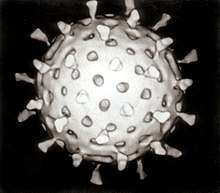Arbitrium
Arbitrium is a viral peptide produced by bacteriophages to communicate with each other.[1] It is six amino acids long, and is produced when a phage infects a bacterial host. It signals to other phages that a host has been infected.
Discovery
Arbitrium was first observed by a team led by Rotem Sorek, a microbial geneticist at the Weizmann Institute of Science in Israel.[2][3] They were studying communication in Bacillus subtilis bacteria - in particular, how bacteria infected with phages warn nearby uninfected bacteria about the presence of these viruses. They found that the phages (strain phi3T) communicated with each other to co-ordinate their infection.[1]
Mechanism
Many phages, known as temperate phages, when they infect a bacterium, may enter either the lytic or the lysogenic pathway. The lytic pathway causes the host to produce and release a large number of daughter phages, usually killing it in the process. The lysogenic pathway involves the virus inserting its genome into the bacterium's. At a later stage, the viral genome is activated, and it continues along the lytic pathway of producing several daughter phages.
Arbitrium is used by at least some phages to decide how common fresh hosts are. Each infection causes the production of some arbitrium, and the remaining phages gauge the concentration of arbitrium around them. If the arbitrium concentration is too high, it may indicate that uninfected hosts are running out. The viruses then switch from lysis to lysogeny, so as to not deplete all available hosts.[1]
According to a team led by Alberto Marina at the Biomedical Institute of Valencia in Spain, also studying the Bacillus subtilis/ SPbeta phage system, arbitrium (AimP) binds to the AimX transcription factor AimR, and suppresses the activity of AimX, a negative regulator of lysogeny.[4][5][6] Marina has also shown in the same system that the virus's arbitrium receptor interacts not only with bacterial genes that help it reproduce, but also with several other stretches of DNA. He has suggested that arbitrium signals may be able to alter the activity of important bacterial genes.[1]
More recently, another team at the Sorek lab, headed by Avigail Stokar-Avihail and Nitzan Tal, has shown similar systems in other species of Bacilllus bacteria, the pathogenic species Bacillus anthracis, Bacillus cereus, and Bacillus thuringiensis. [7] They speculate that "the occurrence of peptide-based communication systems among phages more broadly remains to be explored." [7]
Applications
Sorek has suggested that since human viruses like HIV and herpes can cause active and latent infections, they might be using an arbitrium-like system to communicate. In this case, that analogue could be used to suppress infections by making the viruses completely latent.[1][2] Prof. Martha Clokie, of the University of Leicester, has hailed the discovery of viral communication as 'transformative'.[2]
See also
- Quorum sensing - the corresponding phenomenon in bacteria
References
- Dolgin, Elie (2019). "The secret social lives of viruses". Nature. 570 (7761): 290–292. doi:10.1038/d41586-019-01880-6. PMID 31213694.
- Callaway, Ewen (2017). "Do you speak virus? Phages caught sending chemical messages". Nature. doi:10.1038/nature.2017.21313.
- Erez, Zohar; Steinberger-Levy, Ida; Shamir, Maya; Doron, Shany; Stokar-Avihail, Avigail; Peleg, Yoav; Melamed, Sarah; Leavitt, Azita; Savidor, Alon; Albeck, Shira; Amitai, Gil; Sorek, Rotem (2017-01-26). "Communication between viruses guides lysis–lysogeny decisions". Nature. 541 (7638): 488–493. doi:10.1038/nature21049. ISSN 0028-0836. PMC 5378303. PMID 28099413.
- Gallego del Sol, Francisca; Penadés, José R.; Marina, Alberto (2019). "Deciphering the Molecular Mechanism Underpinning Phage Arbitrium Communication Systems". Molecular Cell. 74 (1): 59–72. doi:10.1016/j.molcel.2019.01.025. PMC 6458997. PMID 30745087.
- Guan, Zeyuan; et al. (2019). "Structural insights into DNA recognition by AimR of the arbitrium communication system in the SPbeta phage" (PDF). Cell Discovery. 5: 29–. doi:10.1038/s41421-019-0101-2. PMID 31149347.
- Dou C, Xiong J, Gu Y, Yin K, Wang J, Hu Y, Zhou D, Fu X, Qi S, Zhu X, Yao S. Structural and functional insights into the regulation of the lysis–lysogeny decision in viral communities. Nature microbiology. 2018 Nov;3(11):1285.
- Stokar-Avihail A, Tal N, Erez Z, Lopatina A, Sorek R. Widespread Utilization of Peptide Communication in Phages Infecting Soil and Pathogenic Bacteria. Cell host & microbe. 2019 May 8;25(5):746-55.
